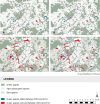Effect of changes in green spaces on mental health in older adults: a fixed effects analysis
- PMID: 31630120
- PMCID: PMC6929698
- DOI: 10.1136/jech-2019-212704
Effect of changes in green spaces on mental health in older adults: a fixed effects analysis
Abstract
Background: Urban green spaces have been linked to different health benefits, but longitudinal studies on the effect of green spaces on mental health are sparse and evidence often inconclusive. Our objective was to study the effect of changes in green spaces in the residential environment on changes in mental health using data with 10 years of follow-up (2004-2014).
Methods: Data from 3175 Dutch adults were linked to accessibility and availability measures of green spaces at three time points (2004/2011/2014). Mental health was measured with the Mental Health Inventory-5. Fixed effects analyses were performed to assess the effect of changes in green spaces on mental health.
Results: Cross-sectional analysis of baseline data showed significant associations between Euclidean distances to the nearest green space and mental health, with an increase of 100 m correlating with a lower mental health score of approximately 0.5 (95% CI -0.87 to -0.12) on a 0-100 scale. Fixed effects models showed no evidence for associations between changes in green spaces and changes in mental health both for the entire sample as well as for those that did not relocate during follow-up.
Conclusions: Despite observed cross-sectional correlations between the accessibility of green space in the residential environment and mental health, no evidence was found for an association between changes in green spaces and changes in mental health. If mental health and green spaces are indeed causally linked, then changes in green spaces in the Eindhoven area between 2004 and 2014 are not enough to produce a significant effect.
Keywords: ageing; geographical information systems; mental health; urban development; urban health.
© Author(s) (or their employer(s)) 2020. Re-use permitted under CC BY. Published by BMJ.
Conflict of interest statement
Competing interests: None declared.
Figures


Similar articles
-
Green Space Attachment and Health: A Comparative Study in Two Urban Neighborhoods.Int J Environ Res Public Health. 2015 Nov 12;12(11):14342-63. doi: 10.3390/ijerph121114342. Int J Environ Res Public Health. 2015. PMID: 26569280 Free PMC article.
-
Public green spaces and positive mental health - investigating the relationship between access, quantity and types of parks and mental wellbeing.Health Place. 2017 Nov;48:63-71. doi: 10.1016/j.healthplace.2017.09.002. Epub 2017 Sep 23. Health Place. 2017. PMID: 28942343
-
Availability, use of, and satisfaction with green space, and children's mental wellbeing at age 4 years in a multicultural, deprived, urban area: results from the Born in Bradford cohort study.Lancet Planet Health. 2018 Jun;2(6):e244-e254. doi: 10.1016/S2542-5196(18)30119-0. Lancet Planet Health. 2018. PMID: 29880156
-
The impact of green spaces on mental health in urban settings: a scoping review.J Ment Health. 2021 Apr;30(2):179-193. doi: 10.1080/09638237.2020.1755027. Epub 2020 Apr 20. J Ment Health. 2021. PMID: 32310728
-
Green space and the health of the older adult during pandemics: a narrative review on the experience of COVID-19.Front Public Health. 2023 Jul 31;11:1218091. doi: 10.3389/fpubh.2023.1218091. eCollection 2023. Front Public Health. 2023. PMID: 37601191 Free PMC article. Review.
Cited by
-
A Canonical Correlation Analysis Study on the Association Between Neighborhood Green Space and Residents' Mental Health.J Urban Health. 2023 Aug;100(4):696-710. doi: 10.1007/s11524-023-00756-5. Epub 2023 Aug 3. J Urban Health. 2023. PMID: 37535303 Free PMC article.
-
Neighborhood Built Environments and Health in Later Life: A Literature Review.J Aging Health. 2025 Jan;37(1-2):3-17. doi: 10.1177/08982643231217776. Epub 2023 Nov 23. J Aging Health. 2025. PMID: 37994863 Free PMC article. Review.
-
Impact of green infrastructure in smart older adult care communities on the health of the older adult and the exploration of optimization paths.Front Public Health. 2025 Jun 9;13:1601102. doi: 10.3389/fpubh.2025.1601102. eCollection 2025. Front Public Health. 2025. PMID: 40552226 Free PMC article.
-
A systematic review on the associations between built environment and mental health among older people.Front Public Health. 2025 Jul 2;13:1584466. doi: 10.3389/fpubh.2025.1584466. eCollection 2025. Front Public Health. 2025. PMID: 40672928 Free PMC article.
-
Association between neighbourhood characteristics and antidepressant use at older ages: a register-based study of urban areas in three European countries.J Epidemiol Community Health. 2021 May;75(5):426-432. doi: 10.1136/jech-2020-214276. Epub 2020 Jun 20. J Epidemiol Community Health. 2021. PMID: 32563994 Free PMC article.
References
-
- Brenner N, Schmid C. The ‘Urban Age’ in Question. Int J Urban Reg Res 2014;38:731–55. 10.1111/1468-2427.12115 - DOI
-
- Egorov A, Mudu P, et al. , World Health Organization . Urban green spaces and health - A review of evidence. Copenhagen: WHO Regional Office for Europe, 2016.
Publication types
MeSH terms
LinkOut - more resources
Full Text Sources
Medical
